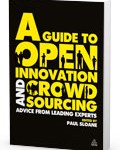Apr15
How Open Innovation & Modularity Accelerate Innovation at PsionTeklogix
Point: Use open innovation and modularity to identify new product/service needs and accelerate your pace of innovation
Story: Rugged handheld computers are used every day by retailers,warehouse operators, service technicians, parcel companies, and transportation operators to log customer purchases, track inventory, monitor shipments, and scan tickets. Half a dozen manufacturers compete in the crowded market for these devices to serve customers who want everything — devices that are hardy, high-tech, compact, inexpensive, and suited to their particular needs.
retailers,warehouse operators, service technicians, parcel companies, and transportation operators to log customer purchases, track inventory, monitor shipments, and scan tickets. Half a dozen manufacturers compete in the crowded market for these devices to serve customers who want everything — devices that are hardy, high-tech, compact, inexpensive, and suited to their particular needs.
PsionTeklogix needed to differentiate itself from competitors like Motorola, Intermec, Datalogic, Honeywell, and LXE. The company created a modular platform strategy called Omnii with interchangeable keyboards, scanners, communications modules, screens, grips and optional features like a camera and GPS. Rather than build small volumes of unique devices for each application or new technology, Psion created a modular platform to build components in cost-effective volumes and then mix-and-match the parts to create a custom-built assembly.
For example, Psion or one of its partners can create a new RF communications module (e.g., for a new cellular data standard) and then plug that module into many of the pre-existing Omnii products. This strategy accelerates innovation because it’s faster and cheaper to design a new module than to redesign an entire product. This strategy also accelerates adoption of innovation by customers because customers don’t have to replace all their handheld computers, only swap in the new modules.
Then, Psion went a step further, introducing its Open Source Mobility initiative. Psion created IngenuityWorking.com, an open, collaborative online community for Psion employees, developers, partners and customers. The goals are twofold:
- to leverage Psion’s large IP portfolio with a wide range of vendors and component suppliers
- to give customers and resellers the ability to voice needs and identify micro-niches in the market.
In summary:
- PSION uses its IngenuityWorking.com site with customers, developers and partners to drive product developments
- Psion leverages its strengths (modularity & customization) to reduce waste, improve time to market and gain new commercial options
Action:
- Create product/service architectures than enable fast insertion of new technologies. In Psion’s case, interchangeable displays, user interfaces, scanners, radios, etc. all combine to provide a myriad of combinations of functionality inside the rugged case.
- Create an online community among your partners and customers to learn their needs and identify new product/service opportunities.
- Populate the OI site with technical information that helps partners contribute practical and compatible innovations
- Allow customer complaints on the site (valid complaints, not offensive vitriolic rants). This transparency builds trust over time as customers and partners see how you address problems.
For more information, see Todd Boone of PsionTeklogix’s chapter in A Guide to Open Innovation and Crowdsourcing, edited by Paul Sloane, published by Kogan Page 2011.
Comments Off on How Open Innovation & Modularity Accelerate Innovation at PsionTeklogixCase study, Growth, How-to, Innovation, New Product Development, open innovation









